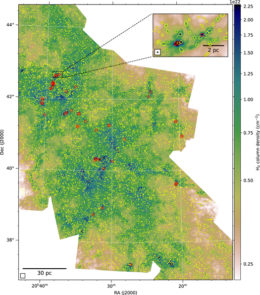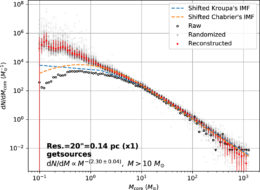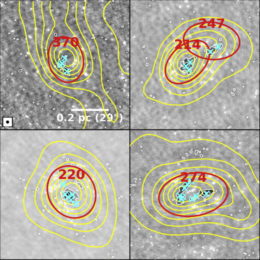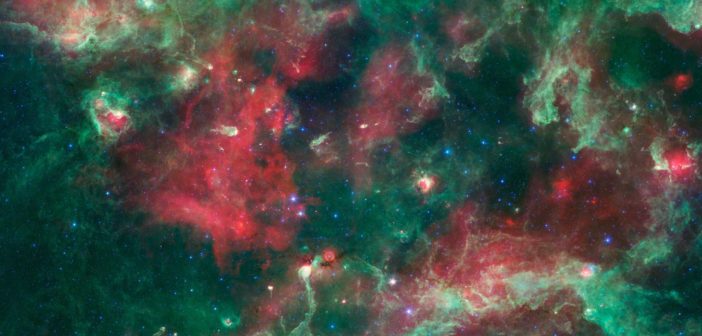Astronomers have long attempted to understand why star-forming regions generate just a few high-mass stars while churning out many low-mass stars. Today’s article investigates a giant molecular cloud complex to understand the connection between dense, dusty cores and the stars that they form.
Scales Large and Small

Thousands of cores (yellow ellipses) are visible in this hydrogen column density map of Cygnus X derived from Herschel Space Observatory data. Cores selected for later follow-up are indicated in red. [Cao et al. 2021]
Astronomers use the core mass function and the initial mass function to describe the number of cores and stars, respectively, that form in a molecular cloud as a function of mass. Thus far, observations indicate that the core mass function and the initial mass function both show the same strong preference for forming small objects over large ones, leading astronomers to suggest that the functions are closely related. To test this picture and explore the roots of this relationship, a team led by Yue Cao (Nanjing University, China) has now dramatically expanded our sample of star-forming cores by analyzing observations of the enormous Cygnus X giant molecular cloud complex.
An Extensive Search
In order to determine the core mass function precisely, Cao and collaborators needed a large sample of cores. Their search brought them to the Cygnus X star-forming region: a 650-light-year-wide molecular cloud containing three million solar masses of gas and dust and home to thousands of star-forming cores.

Corrected core mass function for Cygnus X (red symbols) compared against the uncorrected core mass function (black symbols) and two initial mass functions (IMFs; dotted lines). [Cao et al. 2021]
After accounting for biases in their search algorithm, the authors found that while the core mass function generally follows the same shape as the initial mass function, there are discrepancies at both mass extremes; Cygnus X has more low-mass cores and fewer high-mass cores than expected if the core mass function is directly related to the initial mass function. This contradicts findings from smaller studies of star-forming regions, which found greater agreement between the shapes of the two mass functions.
From Cloud to Core to Condensation

Selected observations of cores. Hydrogen density contours are in yellow, core diameters are in red, and condensations are marked with cyan crosses. [Adapted from Cao et al. 2021]
Overall, these results indicate that the initial mass function doesn’t arise directly from the core mass function, perhaps due to the chaotic influence of turbulence in star-forming regions. As always, star formation is anything but simple!
Citation
“Core Mass Function of a Single Giant Molecular Cloud Complex with ∼10,000 Cores,” Yue Cao et al 2021 ApJL 918 L4. doi:10.3847/2041-8213/ac1947
